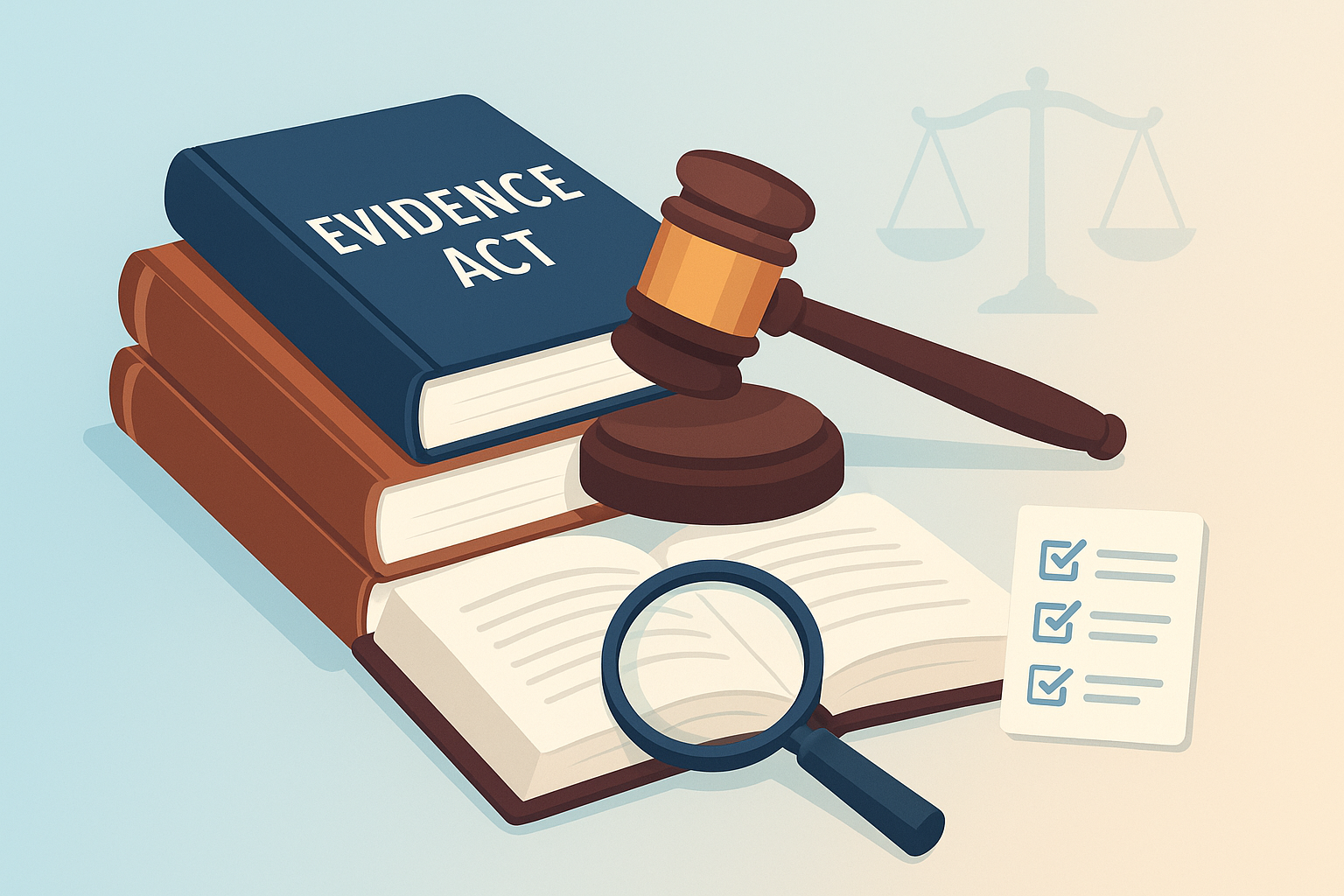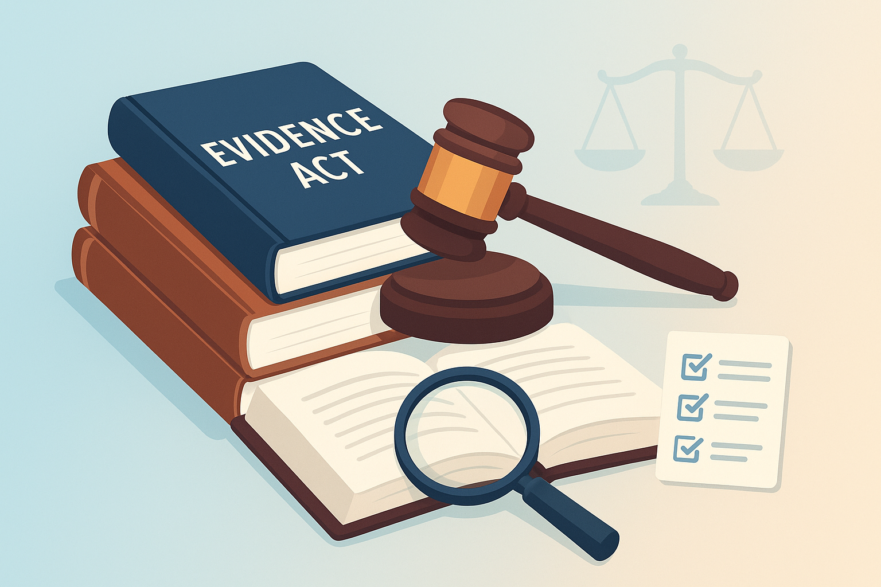
📜 The Indian Evidence Act 1872
Background and Enactment
The Indian Evidence Act was passed by the Imperial Legislative Council in 1872. It contains a set of rules governing admissibility of evidence in Indian courts of law. This enactment was a path-breaking judicial measure which changed the entire system of admissibility of evidence in courts of law in India.
This law is based upon the seminal work by Sir James Fitzjames Stephen, who can truly be called the founding father of this comprehensive piece of legislation.
Over a period of almost 150 years, the Indian Evidence Act has basically retained its original form except certain small amendments here and there.
Applicability
This Act applies:
- ✅ to all judicial proceedings in any Court except Courts-martials
But not:
- ❌ to affidavits presented to any Court or Officer
- ❌ to proceedings before an arbitrator
Where “Court” includes:
- ⚖️ all Judges and Magistrates
- ⚖️ all persons legally authorized to take evidence except arbitrators
Some Definitions
Evidence
Means and includes:
- All statements which Court permits or requires to be made before it by witnesses in relation to matters of fact under inquiry. Such statements are called oral evidence.
- All documents including electronic records produced for inspection of Court. Such documents are called documentary evidence.
Fact
Means and includes:
- Any thing, state of things or relation of things capable of being perceived by the senses
- Any mental condition of which any person is conscious
Relevance of Facts
One fact is said to be relevant to another:
- When it is connected with the other in ways referred in this Act relating to relevancy of facts
Fact in Issue
Means and includes any fact from which either by itself or in connection with other facts existence, non-existence, nature or extent of any right, liability or disability asserted or denied in any suit or proceeding necessarily follows.
Proved, Disproved, and Not Proved
- Proved: When the Court either believes it to exist or considers its existence so probable that a prudent man ought to act upon the supposition that it exists
- Disproved: When the Court either believes that it does not exist or considers its non-existence so probable that a prudent man ought to act upon the supposition that it does not exist
- Not Proved: When it is neither proved nor disproved
Section 6: Facts Forming Part of Same Transaction
Facts which though not in issue are so connected with a fact in issue as to form part of the same transaction are relevant, whether they occurred at the same time and place or at different times and places.
Illustration (a)
A is accused of murder of B by beating him. Whatever was said or done by A or B or the by-standers at the beating or so shortly after it as to form part of the same transaction is a relevant fact.
Illustration (c)
A sues B for a libel contained in a letter forming part of a correspondence. Letters between the parties relating to the subject out of which the libel arose forming part of the correspondence are relevant facts though they do not contain the libel itself.
Illustration (d)
The question is whether certain goods ordered from B were delivered to A. The goods were delivered to several intermediate persons successively. Each delivery is a relevant fact.
Res Gestae
Res Gestae is a Latin word which means “things done”. The principle of law embodied in Sec. 6 of the Evidence Act is usually known as the rule of res gestae.
The essence of the doctrine is that a fact which is so connected with the fact in issue as to form part of the same transaction becomes relevant by itself.
Hearsay evidence is not admissible in a court of law. But res gestae is an exception to the hearsay rule. Why is it so?
It is a spontaneous declaration by a person made immediately after an event and before the mind has an opportunity to conjure a false story. The rationale behind this rule is the spontaneity and immediacy of the statement so that there is hardly any time for concoction.
When it is proved that the evidence forms part of the same transaction, it becomes admissible u/s 6, but whether it is reliable or not depends on the discretion of the Judge.
Res gestae is an exception to the rule against hearsay evidence. It is based on the belief that, because certain statements are made naturally, spontaneously, and without deliberation during the course of an event, they leave little room for misinterpretation upon hearing by someone else (e.g., by the witness, who will later repeat the statement to the court).
Illustration
Imagine a young woman (the witness) standing on the side of a main road. On the opposite side she sees an old man and hears him shout “The bank is being robbed!”, as a young man runs out of a building and away down the street. The old man is never found (and so cannot appear in court to repeat what he said), but the woman repeats in court what she heard him say.
Such a statement would be admissible as evidence because the statement was made concurrently with the event and there is little chance that the witness repeating the hearsay could have misunderstood its meaning or the speaker’s intentions.
📚 Continue Your Evidence Act Preparation
Don’t stop here! Strengthen your knowledge of the Evidence Act with our other fully solved tests:
📘 Free Study Material for Judiciary Aspirants!
Download our FREE study material prepared by Delhi Law Academy’s expert faculty.
– Disproved: Court believes the fact does not exist or considers non-existence highly probable.
– Not proved: Fact is neither proved nor disproved.
Contact us
📍 Delhi Law Academy – Jaipur Branch
6C, Tower 2, Coaching Hub, Pratap Nagar, Jaipur – 302033
📞 Phone:
+91 9911916552
+91 8447285606
✉️ Email:
contactus@delhilawacademy.com

